What’s Really Going on with the Camas National Wildlife Refuge?
The Camas National Wildlife Refuge is an 11,000 acre wildlife refuge managed by the U.S. Fish and Wildlife Service located just west of I-15 near Hamer. It was established in 1937 via executive order by President Franklin Delano Roosevelt. FDR established Camas to “serve as a refuge and breeding ground for migratory birds and other wildlife,” and for the “conservation, management, and…restoration of the fish, wildlife, and plant resources and their habitats…for the benefit of present and future generations of Americans…”
During the 2025 legislative session, the Idaho Legislature passed Senate Joint Memorial 104 - a nonbinding statement that highlights management challenges with the Camas National Wildlife Refuge and expresses the desire to transfer ownership of the Refuge to the state of Idaho. The primary complaint was about the slow permitting process for clearing debris from Camas Creek, leading to water delivery issues.
While IWF recognizes the challenges inherent in managing mixed-use landscapes, particularly when it comes to water issues in our state, we are steadfast in our view that meaningful collaboration among stakeholders, policy makers, and land managers is the right path forward to solve these differences - not surrendering thousands of acres from the public trust in a process that would almost certainly result in privatization of this landscape. For this reason, we opposed SJM 104.
Camas has a rich history and has provided strong wildlife habitat, though changes in water use have altered the landscape. Prior to its designation as a Refuge, about 30 property owners ranched and farmed on what we know as Camas NWR today. The Brindley Barn is the sole structure that remains from the days prior to establishment of the refuge. Today, sandhill cranes, waterfowl, songbirds, pronghorn, deer, and elk all find a place on the refuge- many of them passing through as part of their annual migrations.
Since about 1990, the wetlands within Camas have been artificially maintained due to the lowering of the water table. Most of the water is diverted from Camas Creek. About 13 miles of ditches line the refuge to transport water to maintain wetlands. In the 70s, groundwater hovered around ground level, but today it has dropped as much as 20 feet. This is a small example of bigger issues with the Eastern Snake River Plain Aquifer, largely due to the change in agricultural practices and water efficiency measures. There have been substantial efforts to improve water distribution on the refuge - most recently with an influx of $7.8 million from the Great American Outdoors Act. But things still aren’t perfect.
The driving force behind SJM104 lies about 15 miles to the West of Camas in the Mud Lake Area. Water users in the Mud Lake Area have grown increasingly frustrated with the quantity of water that flows from Camas Creek down to Mud Lake. SJM104 states “Mud Lake was seasonally flooded when Camas Creek would overflow and create temporary wetlands, which would progressively recharge the aquifer lying underground…” and “Camas Creek has become obstructed by willows and sedimentation building up such that water is not being properly delivered to the Mud Lake water users.” Water users in the area have also become increasingly frustrated with federal permitting that would allow for the dredging and discharge of fill material from Camas - actions that water users claim would help deliver water to Mud Lake.
The Joint Memorial goes on to state that the federal permitting process is cumbersome, that water users would benefit from state ownership of Camas due to less onerous state permitting, and that water right holders have experienced ongoing injury due to federal inefficiencies and inaction.
IWF does not take the issue of water rights or delivery lightly, but we do urge practical solutions to real challenges. There is also no reason to believe that the federal government would simply hand the land over to the state for free, or that Idaho would be in a position to bid were it offered for sale - so while SJM104 requests the land be transferred to the Idaho Department of Fish and Game, it is far more likely that the land would fall into private hands in the event of a disposal and fish and wildlife conservation values would no longer be the primary management drivers on the landscape.
Instead of pursuing actions that would have no real impact on the ground and that could deprive Idahoans of public land we can all now freely access, IWF encourages stakeholders to collaborate with staff at the Camas NWR, the Administration, and others to improve management and permitting challenges rather than pressing for the disposal of almost 11,000 acres of our nation’s public lands. IWF and our partners stand at the ready to help improve management challenges on federal lands to make a better system for all. Part of that system is for these lands to remain productive, healthy, and in public hands.
IWF appreciates the background of Camas NWF from Golden Eagle Audubon Society and Friends of Camas National Wildlife Refuge. Check more out here.
